Excel Converting USA Dates to UK Dates
Table of Contents

Converting USA Dates to UK Dates
Excel Converting USA Dates to UK Dates. Usually Excel date values don’t cause any problems, you just type them in with either slash or dash separators. Don’t bother about the year value unless your date is for a year other than the current year. Excel automatically enters the current calendar year if you just give day and month values.
Country Setting for Dates
However, you will have a problem with the date evaluation if the country setting on your system has not been set correctly. Excel was written in the USA and uses their Month-Day-Year date convention. You will have to change the country setting if you want to use the UK convention of Day-Month-Year.

Reversing the Date Evaluation
You can Google formulas that will reverse the date evaluation for you but they are awkward to implement if you have to do this sort of thing regularly. In this article we are going to create a Date Converter that reverses the day and month values of any date directly in the cell without having to use formulas.
The converter uses an Excel macro which is triggered when you click a shortcut button on your Quick Access Toolbar (QAT). You click the button, select the range of cells containing your dates and you’re done!

Converting UK Dates to USA Dates
It also works the other way round. So, if someone from the London office sends you a spreadsheet and the dates are entered in good-old-King-George Day-Month order you just select your cells and click your shortcut. The date evaluation is whizzed around into nice, sensible Month-Day dates.

Making the Date Converter macro
Step 1. Recording a macro
The first step is to record a macro into your Personal Macro Workbook. This is a hidden workbook that is opened automatically whenever Excel starts up, any macros saved in this workbook will always be available for you to use.
Go to the Macros control which is found on the extreme right-hand side of the View tab on the Excel ribbon. Click the bottom section of the control and choose Record Macro from the menu.

Step 2. Using the Personal Macro Workbook
There is very little to do here other than to make sure that you record a macro in the right place.
When the dialog is displayed, change the Store macro in setting to Personal Macro Workbook. It’s available in the drop down list. Don’t bother with anything else. Click OK to start the recorder.
Whatever you do now gets recorded but there’s no need to do anything. Just turn off the recorder and this step is completed. Click Stop Recording in the menu on the Macros control.

Step 3. Finding the recorded macro
We have now created a module (Excel’s storage area for macros) in the Personal Macro Workbook. The next step is to find this module, remove the recording and replace it with the instructions that will do the date conversion work for us.
This is done in the Visual Basic Editor. Press ALT+F11 to open the editor and then see if you can spot a window in the top left-hand corner which looks like this illustration. That’s the Project Explorer window. If you can’t see it, press Ctrl+R.
Look in the listing under PERSONAL.XLSB, you may have to click the plus sign nodes to open up the listing. If you’ve never used the Personal Macro Workbook before you will need Module1. If there are a set of modules visible then you need the last one. Double-click the module and you will display the code of your recording in the window on the right-hand side of the screen.

Step 4. Copying and Pasting the code for the macro
Your recorded macro code will look something like this illustration. Don’t worry if it doesn’t as we are going to delete it and substitute our own code. Select all your code from the word Sub to the words End Sub and press the DELETE key.
Then copy and paste the code from the section below to replace the original.

This is the code for the date converter macro:
Make sure that you copy and paste everything, starting with the word Public and ending with words End Sub. When you’ve pasted the code you will see that some of the words will turn a blue colour and some green. That’s exactly what they should do.
Step 5. Saving the macro
Now save the workbook. PERSONAL.XLSB is a hidden workbook so save it now as it’s tricky to do it later. Choose File, Save from the main menu.
The macro is completed and we now get back to Excel by pressing ALT+F11 again. Or you can close the Visual Basic Editor window.

Step 6. Creating a shortcut for the macro
In the next few steps we shall create an attractive, easy to use shortcut for the macro.
The most obvious place to have this is on your Quick Access Toolbar. Point to the QAT (top left-hand corner of the Excel window), right-click and choose Customize Quick Access Toolbar from the shortcut menu.

Step 7. Customizing the Quick Access Toolbar
Excel’s Options dialog will display and the Quick Access Toolbar section is activated.
Working from the top left-hand corner of the section, click the Choose commands from drop-down list.
Then click Macros in the list.

Step 8. Assigning the macro to the QAT
Your macro will be displayed in the list on the left-hand side. Select the macro and click the Add command button.
Your macro now appears in the right-hand list which shows you all the shortcuts available on your Quick Access Toolbar.
The next step is cosmetic and will make your shortcut button more visually attractive. Click OK now if you want to skip this final step.

Step 9. Modify the macro button
Click the Modify command button if you want to change the icon displayed for your macro and change the descriptive ‘Screen-Tip’ that pops up whenever you point at the icon.
There’s an array of different icon images to choose from. Enter some text into the Display Name box to set the Screen-Tip text.
You don’t have to enter “Date Converter”, you can enter anything you like. Click OK to close the dialog and OK again to close the main Options dialog.
Step 10. Test the macro
Everything’s done but you always want to test it to make sure. Enter a few dates into your worksheet. Click the Date Converter button on your Quick Access Toolbar. Select the date cells when the input box appears. Click OK and all the dates get switched around.


Using the Date Converter
This is the input box that appears when the shortcut is clicked. Your current cell selection in the worksheet is not detected. Instead, you point out of the box and select a range of cells or a column on your worksheet. All the dates in the selection have their month and day values reversed. Anything that is not a date is ignored.
Congratulations on a successful result and I hope that you enjoyed the Excel converting USA dates to UK dates article.